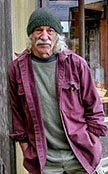The natives of the northwest coast of North America are referred to as First Nations people. In Builders of the Pacific Coast, we have a 12-page section, with 30 vintage photographs of their buildings and totem poles, as well as drawings showing how they raised the huge poles and beams of their remarkable longhouses. (A Salish building discovered by Capt. George Vancouver in 1792 was over 1000 feet long.)

Haida man standing in front of a six-beam Haida house at Haina, Haida Gwaii (formerly called Queen Charlotte Islands), 1888. Note the immaculate carpentry.

Kwakiutl (Kwagiulth) House frame of relatively recent times (note milled wallboards)

From the wonderful book, Cedar: Tree of Life to the Northwest Coast Indians, Copyright 1984 By Hilary Stewart, Douglas and McIntyre, Vancouver/Toronto

Rear totem of the Raven House at Skidegate, Haida Gwaii, Shows (from top) Raven flanked by two frogs, a human figure and the Thunderbird.

Interior post from the caps on big house of Yestaquana at Skidegate, Haida Gwaii. The post, originally painted black, red, white, and blue, stood at the rear of the house, aligned with the front door.
248932
L-R, I assume: Medicine man, Two unidentified women, Old Fox
248950
These hand-tinted drawings are in an old Bureau of Fisheries (Dept of Commerce, USA) book titled Fishes of Alaska, published in 1907 that I acquired years ago.
In order: Red Rockfish, Red Salmon, (breeding male), Red Salmon (breeding female), Dolly Varden Trout. There are a total of 20 such drawings in the book.
I heard this, did some research and found the original by Alvin Robinson (fantastic voice, arranged by Joe Jones), another by the Coasters (Lieber-Stoller production), then the Stones version. The song was written by Jerry Lieber and Artie Butler. I always loved the song, but could never quite figure out the lyrics, but in one search, someone said “…it was filled with the coded language of New Orleans…”
I set it up to play in this order: Alvin/Coasters/Stones/Rainbow Girls (who sing 3-part harmony).
239159
German country house on wheels in 1922.
208989
This old beauty along side Hwy. One in Watsonville, surrounded by 10 acres of organic strawberries and vegetables. Neglected, but the bones are still good. Called the Redman House, it:
“…was constructed in 1897 and designed by William H. Weeks, who was responsible for the design of hundreds of unique buildings throughout California. It was a classic Queen Anne — it featured a rounded corner tower with a turret, gables with meticulously carved panels, Palladian windows and dentil molding. The intricate detailing that Weeks designed for the exterior of the home could also was found inside — expensive and decorative wood, including eastern oak and bird’s eye maple, were used for doors, mantles, and window casings.”
-Wikipedia

Scanned from an old postcard

Bakeitzogie (The Yellow Coyote) – Chiricahua Apache
This is a phenomenal source on Native Americans, with hundreds of archival photos, most of which I have not seen before.
Native Americans
First People is a child friendly site about Native Americans and members of the First Nations. 1400+ legends, 400+ agreements and treaties, 10,000+ pictures, clipart, Native American Books, Posters, Seed Bead Earrings, Native American Jewelry, Possible Bags and more.

This is in the Wells Fargo headquarters in downtown San Francisco.
Wells Fargo began in San Francisco during the gold rush. It acted as a bank and delivery service for miners looking to strike literal gold.
It cost quite a lot of money to transport goods before railroads. In 1867, it would have cost $300 — $7,352 in 2015 dollars — to ride the stagecoach from Sacramento to Omaha, according to an advertisement from the era.
Wells Fargo was able to transfer money and goods quickly and reliably using the stagecoaches. The bank claims that its coaches were made using only the finest materials of the time.
The main builder of these stagecoaches, Abbot & Downing Co., hand assembled the coaches from a variety of woods and rimmed the wheels with iron. It created a suspension system of leather to make the ride more comfortable for passengers crossing deserts and mountains.…
When workers were done with the stagecoaches, they would weigh 2,500 pounds, about as much as a 2016 Toyota Prius C.
The stagecoaches covered 3,000 miles from the West Coast to Nebraska. Once railroads spanning the width of the country were introduced in 1869, stagecoaches began falling out of fashion. They continued serving areas not reachable by rail after that, and Wells Fargo spun off its delivery company in 1905.…
From www.businessinsider.com/…

















